Welcome to where you are: NCEAS murals by artist Elkpen
As you step into the new NCEAS building, a visual intersection of art and ecology will greet you. Local narratives have been brought to life in a series of floor to ceiling art pieces that wrap around our third floor office space. The mural themes are rooted in a powerful sense of place, playing with scale, direction, and orientation across marine, estuary, mountain, and wetland landscapes. Each of the art pieces also conveys a compelling need for connection through observation, instilling a deeper appreciation for the environment around us. “We are all so empowered by being able to see and touch and smell” the artist, Christian Kasperkovitze, who goes by Elkpen, explained. “These senses are greater than tools, they are tactics for connection.”
On her inspiration for the expansive murals, Elkpen noted an urgency for emotional, not logical, ties to the environment: “If you aren’t already connected to the magic of the landscape, how do I get your heart racing?” The art was conceptualized with our director, Ben Halpern, over nearly six months of collaborative conversations before two to three weeks of drawing on site. Describing this synthesis, Ben noted “the collaboration with Christian in designing these immersive murals has been a profoundly rewarding endeavor, reminding us daily of our mission here at NCEAS: to explore novel perspectives and expand our understanding of the natural world.” Below, we go behind the scenes of each wall with the artist, discussing her process and inspiration for her explorations of Santa Barbara’s biodiversity.
Wall One: You are here
"Welcome to where you are, to where we are"
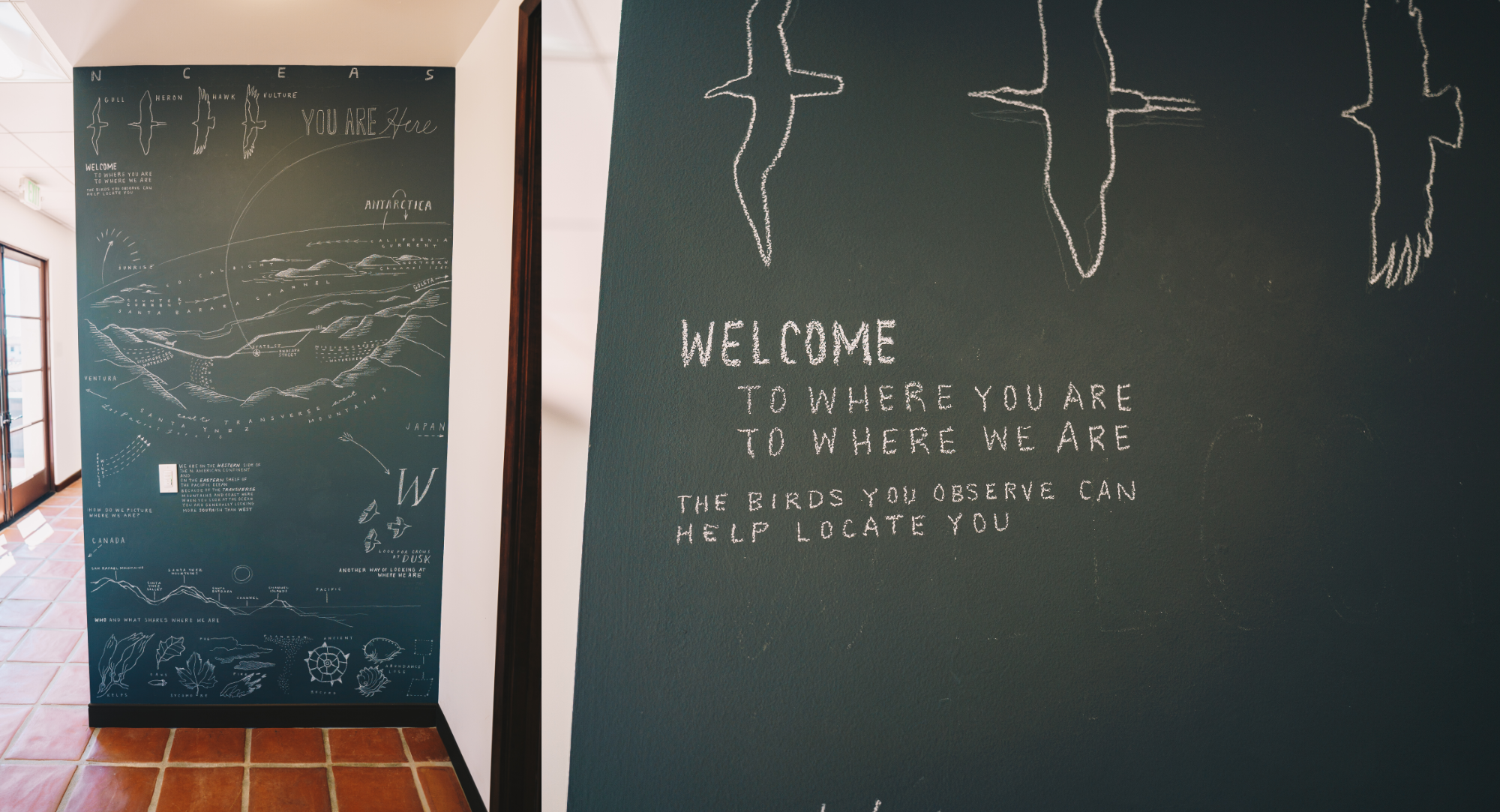
The first mural is situated at the main NCEAS entrance, past the terrace and just to the left of Ginger’s welcoming office. Called “You are here,” this piece perhaps offers the most direct exploration of sense of place and direction, featuring the Santa Barbara landscape in two orientations (a motif repeated in walls two and six) and multiple arrows and notations to situate the viewer. Two subtle arcs stretch across the composition, broadly representing Santa Barbara’s location in latitude and longitude. By the lightswitch, an inscription reads “we are on the western side of the N. American Continent and on the eastern shelf of the pacific ocean,” flipping our typical categorization of east and west coasts by land masses and invoking a creative reimagining of direction that continues throughout the murals. At the bottom, a series of drawings of kelp, oak, and plankton hint at upcoming panels the viewer will encounter as they continue through the hallway. Elkpen’s early influences from her time as a mapmaker are clear in this introductory section. ““We invest so much trust in maps, yet maps might be better understood as interpretations.” Summarizing this mural’s goal, she noted “We forget that we have this intuitive and emotional sense of where we are. I wanted to do that here, imagining where Santa Barbara is without a map or compass – where we sense we are.”
Wall Two: Marine Protected Areas
"So much of where we are we cannot see"
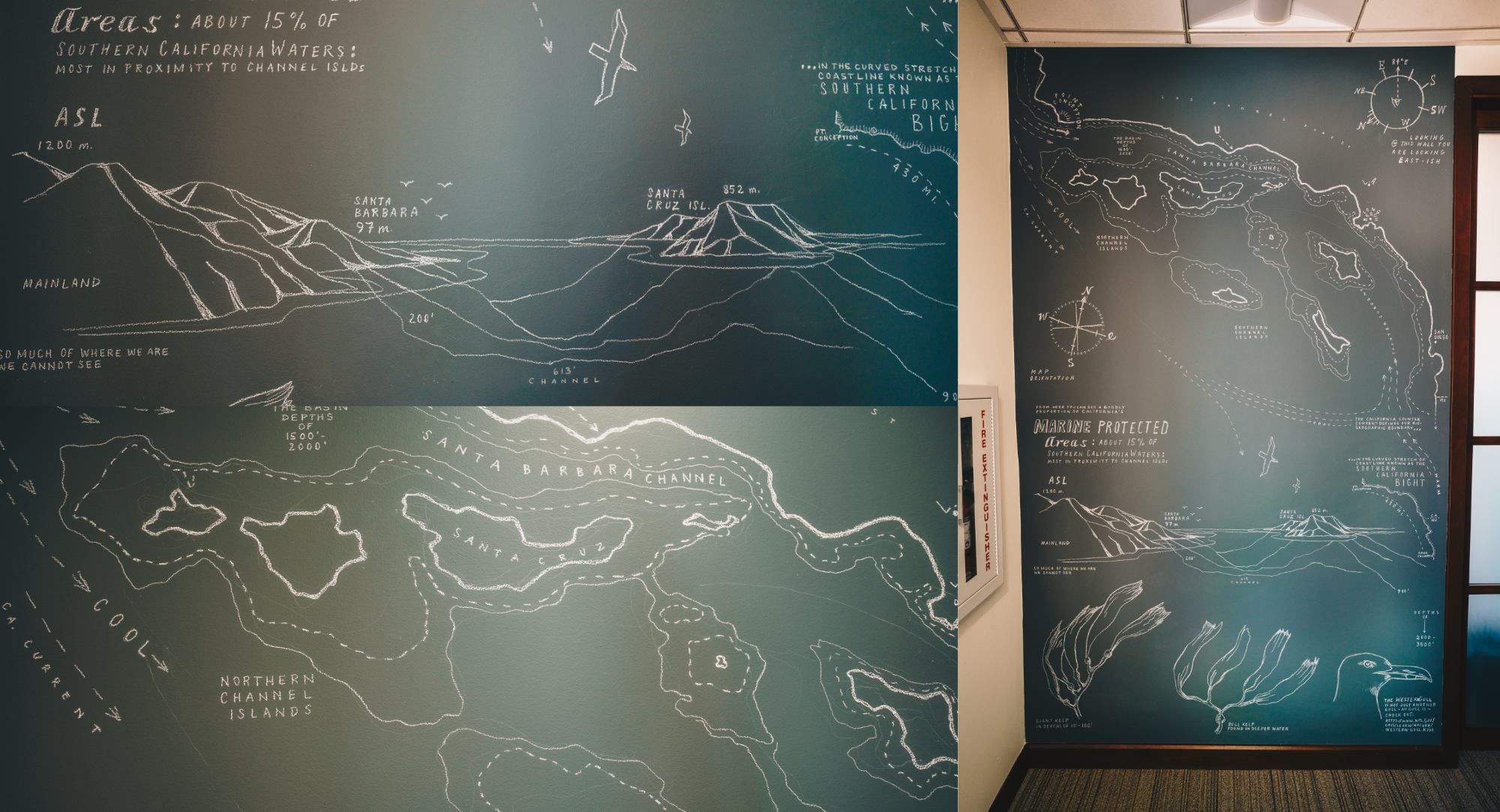
The second mural is located to the left of the first, down a small hallway and next to our Director’s office. Two maps dominate the wall. Stretching over the top third is a classical top-down topographic view of the coast and Channel Islands – an expansive marine protected area that is a recurring focus of NCEAS projects. A compass in the top right corner says “looking at this wall you are looking east-ish,” breaking down the precision often used with location descriptions and allowing space for emotional interpretation. Below, a side view of the same landscape offers another representation of the channel’s depth (an impressive 613 feet chasm between Santa Barbara and Santa Cruz Island), representing what the viewer might see if the walls and building were gone. “That’s why this topic is on this wall” noted Elkpen. “You would be looking out at the ocean, seeing the islands.” Between the two maps is a preliminary spotlight on the California current and countercurrent, expressed as dashed arrows of cold and warm waters that loosely define the Southern California bight ecosystem – the topic of the next mural that hugs the hallway to the right.
Wall Three: The California Current
"In the waters you can see from here"
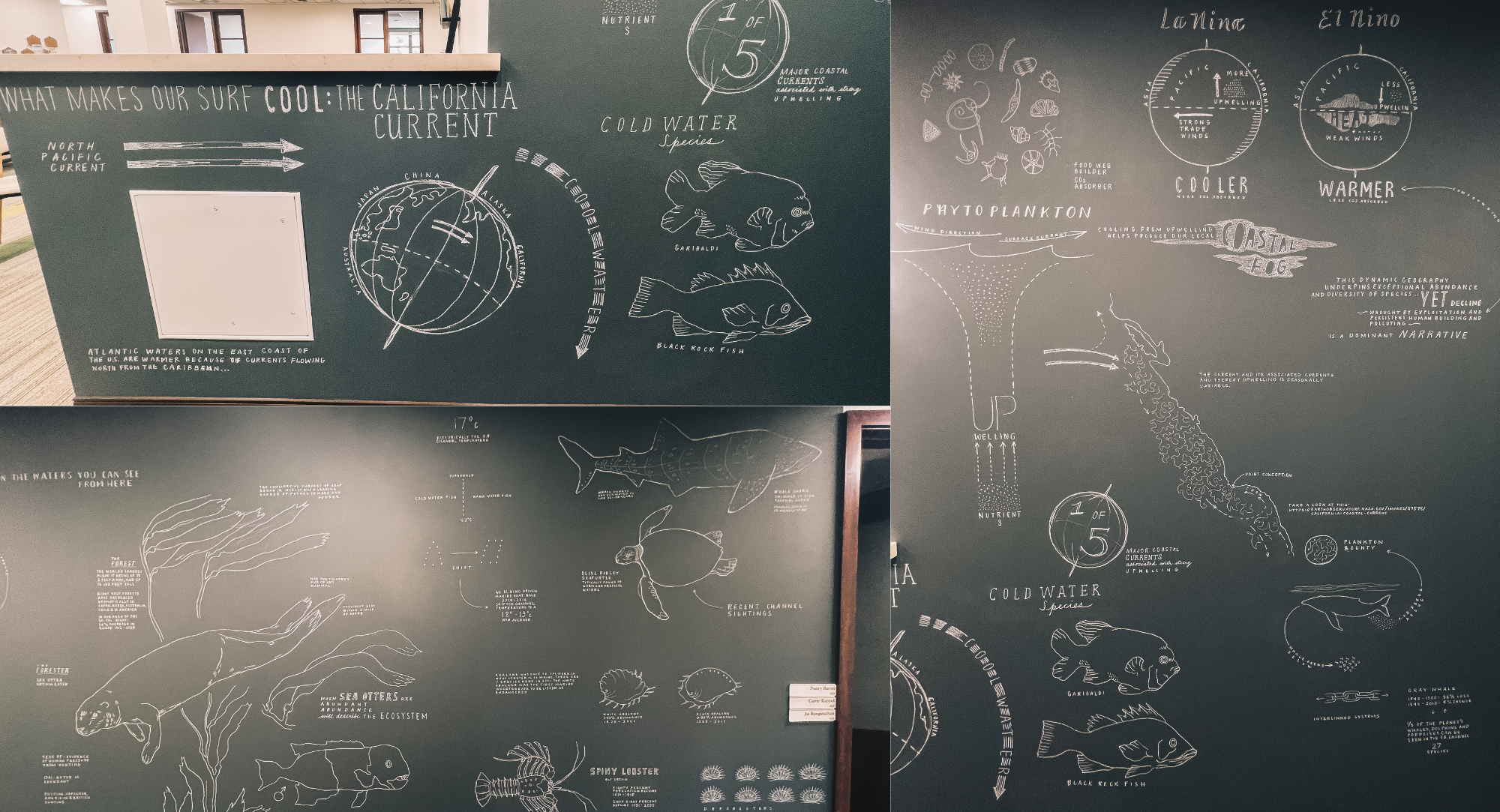
In this mural, which spans the right side of a ~25 foot corridor, Elkpen emphasizes a sense of scale with stories of the California Current system. On the half-wall, she starts zoomed-out, exploring the global context for the cool waters that grace our coastline. Vignettes of plankton highlight her play with contrasting scales, with connecting mosaics of microscopic organisms and their birds-eye coastal view from space. Here, Elkpen also draws the viewer into the effects of climate change on our backyard ecosystems, for example in her inscription of La Nina and El Nino events: “this dynamic geography underpins exceptional abundance and diversity of species… yet decline wrought by exploitation and persistent human building and polluting is a dominant narrative.” This continues in the hallway with discussions of charismatic animals like turtles and whale sharks – species that are starting to appear in warming Santa Barbara waters. On dedicating such a large space to this topic, Elkpen noted “I had never heard of the California Current before this project. Now I think ‘how can anyone living here not know about this?’ It’s so important.”
Wall Four: Look Outside
"Seeing is activist, so is listening"
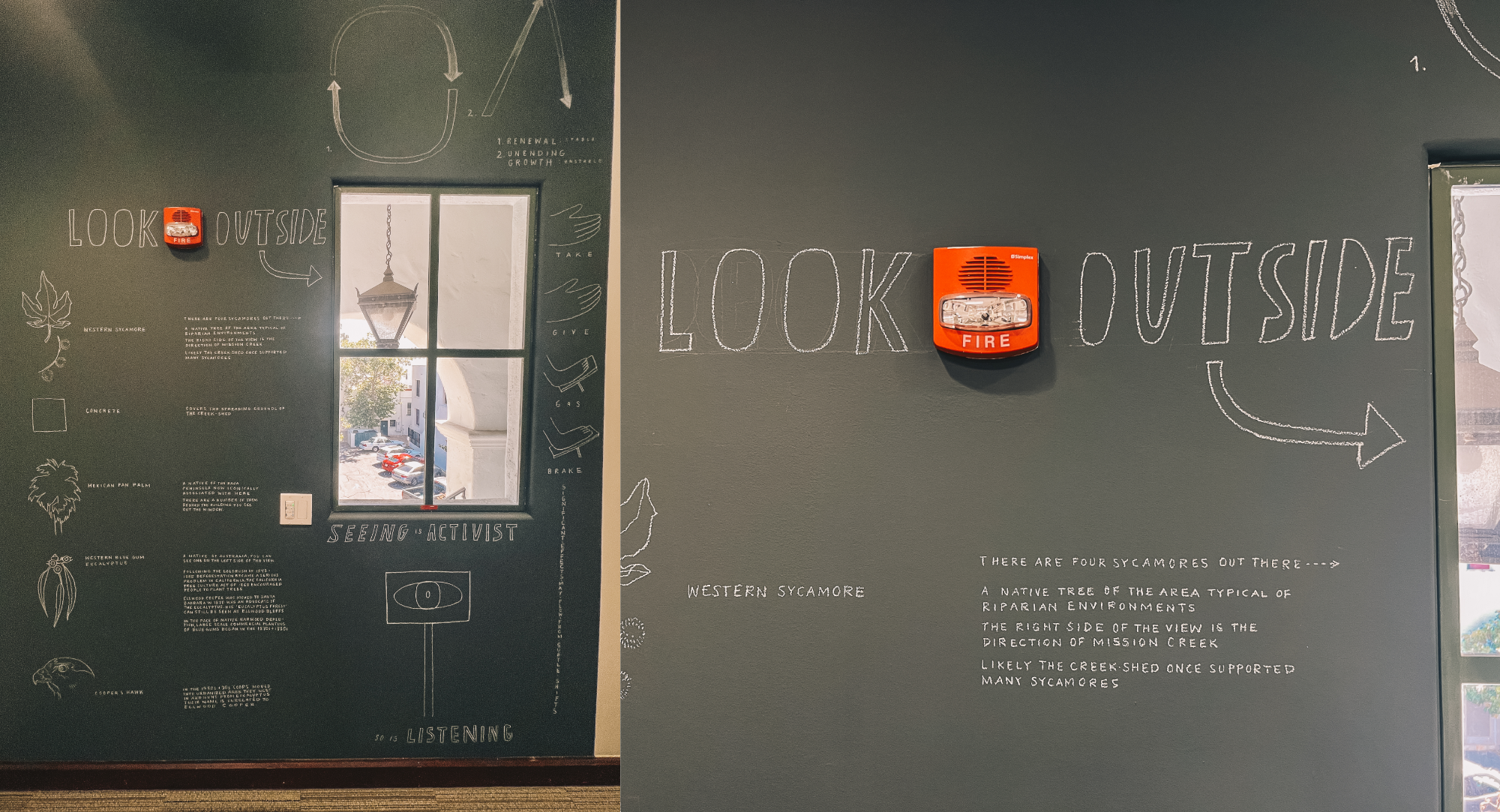
Tucked in the back left corner of the third floor is an unexpected, interactive wall titled “Look outside,” nestled next to a window overlooking the NCEAS parking lot. “I recognized this window as a view you don’t see,” explained Elkpen. “It’s a parking lot, it’s on the way to and from things. We think nature is this big destination, but every step of the way is where you are. I wanted to bring attention to that.” The wall playfully uses natural features to draw viewer attention, like the bright red fire alarm that disrupts the mural’s title or the thin panel to the right of the window, which reads “take, give, gas, brake” – a mantra that seems to encourage self reflection in the landscape. To the left, Elkpen highlighted visible trees like the native Mexican Fan Palm and Western Sycamore. Again, she emphasizes the disruption by human activity by including concrete. “I believe our disconnection from Earth and place and the natural systems that we are a part of and that support us are so amplified by concrete,” she explained. “We don’t put our bare feet on the ground very often. There is so much concrete that we just don’t even see it anymore.”
Wall Five: California Wetlands
"A local story of freshwater and saltwater"
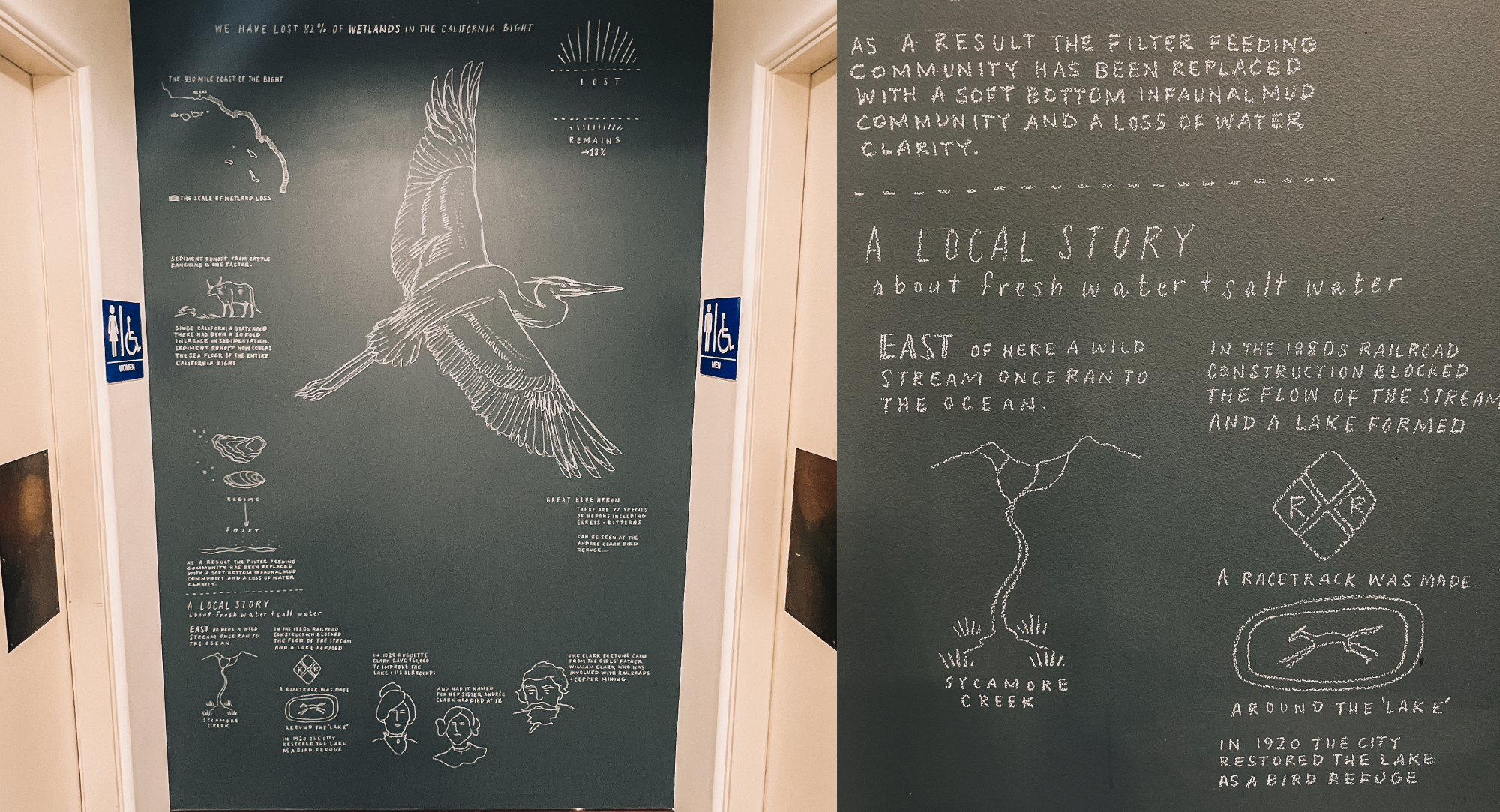
At the back of NCEAS, between two restrooms, is Elkpen’s mural about Santa Barbara’s wetland ecosystem. Dominating the view is a striking drawing of a Great Blue Heron, scaled purposefully to command attention from across the room. On this choice, Elkpen noted “On this wall, I wanted to give a sense of viewing from far away. The bird looks like it is flying past the hallway, almost as if the wall wasn’t there.” The remaining vignettes highlight the history of nearby wetlands, a rare depiction of human faces in a set otherwise dominated by flora and fauna.
Wall Six: Santa Ynez Mountains
"Turn and look over your left shoulder, there rise the Santa Ynez mountains"
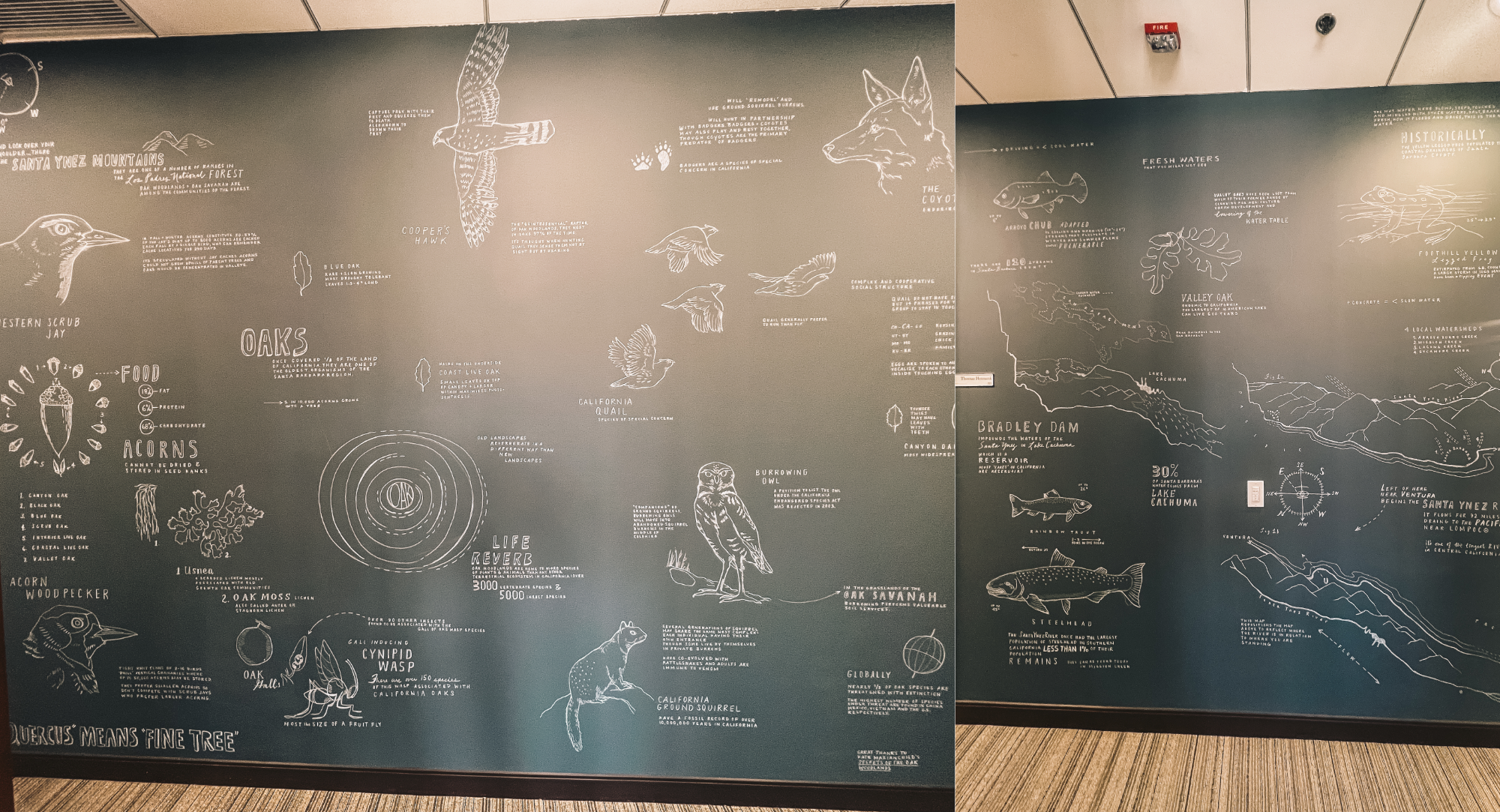
The sixth mural on the Santa Ynez mountains completes a visitor’s clockwise tour of the NCEAS third floor. On the right side of the hallway, the viewer sees multiple maps of the mountain range: first, a zoomed out California, highlighting some of the 120 streams in Santa Barbara County and our largest reservoir, Lake Cachuma. Next, a side view of the major watersheds in the shadow of the mountain ranges. Finally, a version that repositions the maps above to where the viewer is standing, continuing to inspire the audience to claim their sense of place and environmental connection despite being inside an office building. Like the California current hallway, the mural highlights vignettes of species in the ecosystem, with special attention to the effects of climate change. The tone is both serious and whimsical, for example highlighting the California quail as a species of special concern, but also noting that “quail generally prefer to run than fly.” To the left, she dedicates a large wall space to stories of oak species, drawing acorns at large scales and discussing their cooperative ecological adaptations. “It needed to be really engaging, but not too sad of a story” Elkpen clarified on her decisions for the mirrored hallway pieces. “A mark of success in interpretive work would be for people to start understanding Earth systems similar to our own.” In essence: “Welcome to where you are.”
Written by NCEAS Science Communication and Policy officer Alexandra A Phillips following an interview with the artist.
